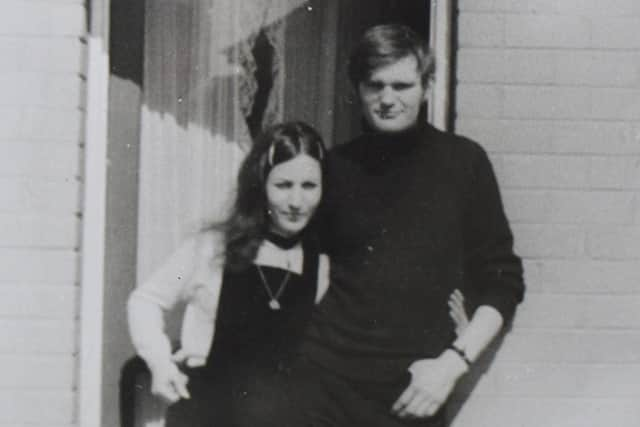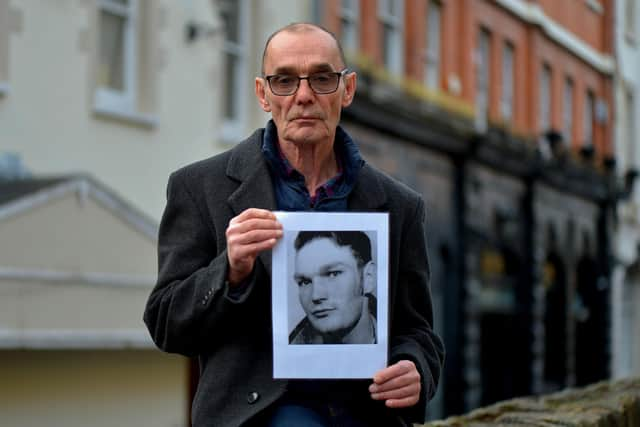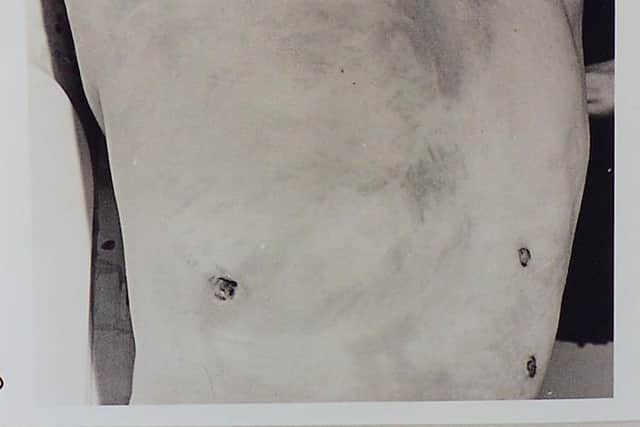Bloody Sunday 50: ‘He fired a second bullet into his back. That was the murder of Jim’
and live on Freeview channel 276
He was just 22 when he was cut down by the Parachute Regiment on Bloody Sunday, but he had an old head on young shoulders.
As the eldest in big family - typical in Derry in those days - he had before his brutal murder been a great support to his parents and brothers and sisters from a young age.
Advertisement
Hide AdAdvertisement
Hide Ad“My father worked on the sites in England so when Jim was 13 or 14 he was like the surrogate father in the house. He supported my mum because there was nine of us. I was four years younger than Jim but he was more or less like a father figure,” recalls his younger brother Liam, who was the second oldest.


The Wrays grew up in the Bishop Street area in a house opposite the Fountain and Albert Street. After attending Long Tower Boys’ School and St. Joseph’s, where he became head boy, Jim left school at sixteen.
“He went to England to seek work. It was tough at the start. A lot of Derry men at the time had to do that because there was very little employment here. He was a lovely character. I’m not saying that because he is my brother. Anybody that knew Jim, the friends or neighbours, would tell you he was a sound big fellah. He was a very solid guy.
“He was like any other Derry man. He would have went to the odd dance. At St. Joe’s he played basketball because he was the height for that.”
Advertisement
Hide AdAdvertisement
Hide AdJim was protective of his family and would always step in if he saw a bully and underdog in uneven contest.


“He was firm if he got angry. You wouldn’t have seen it on many occasions but I remember one boy gave me a thump at a dance hall one night and Jim didn’t get involved but he stopped it. The boys knew he meant business.
“Another time up the Derry Walls me and a few friends were playing football. Jim would have been 17 at the time. We were 13 and always played football up at the Walls or go-karting around the First Derry Primary School. That was our playground. Three ‘Teddy Boys’ came along and took the ball. Jim just happened to be passing by and stopped it. That’s the sort of boy he was.”
Liam says this informed his character and outlook. Jim recognised a good turn. Liam found this out the one and only time he got a chance to share a pint with his older brother.


Advertisement
Hide AdAdvertisement
Hide Ad“I remember I was about 17 or 18. It must have been the months before Bloody Sunday. It was the only time I ever mind being in a bar with our Jim. It was a Saturday night in the Castle Bar. We were having a couple of pints. Not a lot.
“Somebody came in selling The War Cry - The Salvation Army paper [the Protestant church and charitable organisation]. Jim said, ‘Let me tell you something now, if you get an opportunity you always buy that paper and support The Salvation Army. The first week I was in England, that’s where I slept because you couldn’t get a job, you couldn’t get digs and they looked after people’.
“I still give to the Salvation Army the same as I would support Trócaire [the Catholic overseas aid charity]. That was from his experience and the way he looked at people.”
Jim was to get married in the summer of 1972 having met a girl in England. Liam recollects the sense of celebration when Jim brought her home for a holiday around about the time internment was introduced in August 1971.


Advertisement
Hide AdAdvertisement
Hide Ad“He met up with a young girl called Miriam Sidkiahu who was working in London as an au pair and him and her fell in love. She came to Derry, I think it was the August before Bloody Sunday, to meet the family. To be honest with you at that time I was 18 and it was quite exotic seeing this tanned, lovely looking Israeli girl. Him and her were getting married the next year so she came over to meet our family and a beautiful girl she was.
“Then Jim had to go and talk to the local priest to get dispensation because, it’s funny when you think back, a Jewish person was pagan as far as the Catholic church was concerned. Him and her were sorting that out and she was going home to tell her parents the sad news that she was marrying a Christian! The complexities of love and religion!
“Everything was set for a big celebration that next year.”
By this time the family were in Drumcliff Avenue off Cable Street in the heart of the Bogside. The old house up in Bishop Street was vested around 1970. Liam says the whole household was fairly politically engaged at the time but Jim less so, simply because he was away working.
Advertisement
Hide AdAdvertisement
Hide Ad“From when I was 12 or 13 years of age I used to attend a meeting in the Owen Roe O’Neill Hall [a band hall that had been a centre of republican foment from the 1920s] in the Brandywell because I was interested in that sort of thing, obviously the stories and everything else. There were older republicans and it was more or less turning into Republican Clubs at that time. Jim didn’t do that. He was working in England.” When he was back in Derry, however, Jim, like everyone in the city was engulfed in the tumult and the tragedy of those years.
“He experienced my poor neighbour Annette McGavigan being murdered [aged 14, she was shot dead by the British Army on September 6, 1971], and the young fellah Damien Harkin who was crushed by a ‘Saracen’ at the bottom of Westland Street [aged 8, killed by a British Army lorry on July 24, 1971]. Jim was on civil rights marches like myself when he was here.”
The weekend before Bloody Sunday the Wrays were as angered as everyone when demonstrators taking part in a protest against internment at Magilligan were beaten off the beach. Ivan Cooper, the SDLP MP for Mid-Derry was struck on the head with a rubber bullet from point blank range.John Hume, the SDLP MP for Foyle, accused British troops of ‘beating, brutalising and terrorising’ the protestors.
Liam recalls: “When we saw what had happened at Magilligan eight days before, we went out as a family on the march together. There was my mother and father, Jim, me, my younger brother Alex, who is deceased now and my younger sister Geraldine.
Advertisement
Hide AdAdvertisement
Hide Ad“So we went out as a family group on the march. My mum wasn’t great on her breathing. We started off together but you know marches in Derry, they are not marches in the sense of strict military discipline. It’s a dander when you meet friends and you talk and you chat. I ended up lagging back a bit with my mum and my dad and Jim and Geraldine and Alex were sort of all together.”
Liam became separated from Jim but eye-witness accounts and several iconic photographs placed him at the vanguard of the demonstration near the cordons where the march was prevented from moving into the city centre.
One image - captured by the French photojournalist Gilles Peress - shows Jim sitting with his legs crossed in defiant protest at a barrier in William Street
“For me it just signifies and denotes all that Jim was about. The riot is going on around him and if you look carefully the water cannon has just hosed people but Jim is sitting right in the middle of that cross-legged with his arms folded signalling - ‘I’m not moving.’
Advertisement
Hide AdAdvertisement
Hide Ad“Obviously Jim was at the front when he was sitting cross-legged in front of barrier 14. I’m assuming when the army came in he was sitting closer to them than a lot of people would have been unfortunately.”
Another image cherished by Liam shows Jim and another protestor holding a banner at the barrier in Sackville Street.
“Him and another chap are in front of everybody. The soldiers are firing rubber bullets and gas and they are standing there defiantly holding the banner. We are very fortunate. I think we have more photographs of Jim on the day of Bloody Sunday than we had of his whole life up until the aged of 22.
Advertisement
Hide AdAdvertisement
Hide Ad“It’s unbelievable but in the 1950s and 1960s the only photographs you got were either First Communion, Confirmation or weddings. It wasn’t like nowadays.”
Liam was oblivious to it on the day of the massacre itself having become separated from his brother. But it’s now known that when the Parachute Regiment moved into the Bogside Jim was one of a number of victims who had fled into Glenfada Park.
Members of 1 Para Anti-Tank Platoon that had been disgorged from an armoured vehicle made their way into the flats complex and shot several innocent civilians. Jim and William McKinney (aged 27) were shot dead while Joe Friel (aged 20), Michael Quinn (aged 17), Joe Mahon (aged 16) and Patrick O’Donnell (aged 41) were injured.
Having campaigned for justice for fifty years Liam is clear in his mind about what unfolded in Glenfada Park that afternoon.
Advertisement
Hide AdAdvertisement
Hide Ad“Jim was shot trying to get through that exit where Joe Friel and Michael Quinn got through. He was brought down by a shot at that stage and was lying on the ground according to eye-witness testimony. That came from a couple of sources. From young Seosamh [Joe] Mahon who was wounded and survived and was lying behind Jim; from a man who is dead now, Mr. Porter, who was a quartermaster sergeant in the Irish Army who was looking out of one of the houses and could see Jim lying there. And there was another young chap lying in behind the fence at Glenfada Park.
“The triangular observations of Jim showed that he had been lying on the ground and was trying to raise himself up. What I am guessing from what I have seen from the history of the report and the injuries to him is that he may not have been able to move his legs as such as the bullet went across that way and I’m sure it caused a lot of trauma there.
“Jim was attempting to lift himself up when another soldier approached very, very close and fired a second bullet into his back. That was the murder of Jim.”
All this Liam learned later. On the day of the atrocity he had escorted his mother, who was bad with her chest, away from the riot and the tear gas. Eventually he made his way back home and found Drumcliff Avenue a hub of activity.
Advertisement
Hide AdAdvertisement
Hide Ad“Our house was packed. A lot of people were taking shelter. A lot of people had got wet with the water cannons and were rinsing out their coats. My mother said, ‘Go on ahead, don’t worry about it.’ They were heading home hopeful they wouldn’t be arrested.”
James senior arrived but Jim wasn’t with him.
“He said, ‘I’m worried about Jim.’ He wasn’t panicky but he was bit concerned.”
His father told Liam to keep an eye on the house while he went to look for his son.
“I can’t tell you if it was three minutes, five minutes or twenty minutes but my da arrived back in and...this is the tough bit...he said to me ‘Jim’s dead.’ I asked what he meant and he said he was talking to someone there and when he approached people they sort of walked away and he knew something was wrong. He said ‘I think Jim’s dead.’ Not wounded now - dead.”
Advertisement
Hide AdAdvertisement
Hide Ad“He went into the room and he must have said to my mum. You hear that roar... she just let out a roar. Desperation. Despair. Heart torn. My dad got her settled down and the house was empty. Jim was the oldest. I’m only eighteen and I’m sort of in confusion and trying to take it in. I’m not even interested in the younger ones because I’m trying to deal with what is going on. In some ways you don’t believe it.”
Liam travelled to Altnagelvin in order to identify his brother’s body. He recalls members of the security forces - police and soldiers - gloating and taunting the bereaved.
“Outside the morgue there were soldiers and RUC and they were in a form of gaiety. This attitude of laughing and being cocky. You felt this anger inside yourself. We went into the morgue and were asked what we were over for and searched and then we were allowed into the morgue.
“The first thing I saw as I turned in the door and turned into my left was three bodies lying on the floor. I recognised one of them as John Young. I didn’t know who the other two were but I know now. That wasn’t a good sight to see.
Advertisement
Hide AdAdvertisement
Hide Ad“Then as you walked by there was a doorway and the two doors were open into a hall and directly across I could see Jim lying in a trolley bed. I looked at Jim and the only thing I could see was that he had a gouge above his left eye. It was like someone had taken a gouging chisel. I put my hand in it and he was stone cold. He didn’t look himself, the colour was out of his face. He looked like marble and his mouth was open and his eyes were open. I stood there for a moment and thought - he can’t be dead.”
Liam spent the next three days in a daze. He has little recollection of that time now except for the funeral.
“The rain never stopped in that walk down behind the hearse to the cemetery. It was like the heavens were crying. After that we had to get on with it. My dad was always determined. Our family weren’t naive. That’s the way we were brought up. We were politically aware. We believed in our rights and fighting to attain our rights and we weren’t going to be cowed easily.”
This Sunday Liam will march for justice in memory of his brother and the other 13 victims as he has done every year since the atrocity of half a century ago. Time hasn’t healed as you might imagine.
Advertisement
Hide AdAdvertisement
Hide Ad“I’m 68 now. The 50th anniversary touches the emotions maybe a wee bit more. I was 18 that day on the march. I’m 68 now. It’s strange. As you get older you think you would be more settled with it but it touches you more and opens it up a bit more.
“I’ll be out marching the same route as my brother and the other 13 who lost their lives. I’ll be doing it in respectful remembrance but with a lot of pride too. I want to honour the dead and what they stood for and what they marched for. For me on a personal basis it’s bit of a pilgrimage.”
Liam says the ongoing attempt by the British Government to introduce a de facto amnesty for all killings conducted during the conflict in Ireland is an affront and it is imperative that the campaign for justice continues.
“We had two inquiries. What did they tell us? At the end of the second one [the Saville inquiry] they told me that my brother was unjustifiably shot. I know that.
Advertisement
Hide AdAdvertisement
Hide Ad“I’ve been telling you for 50 years. But not one soldier was prosecuted, not one politician prosecuted, no criticism of the RUC at the time which didn’t do their investigation. How come the forensics tried to blacken five people including my brother?...I’m not on a mission of vengeance. I’m on a mission to make sure that things change so that future generations aren’t going to have the same repeat and if you don’t make people accountable it will happen again.”
